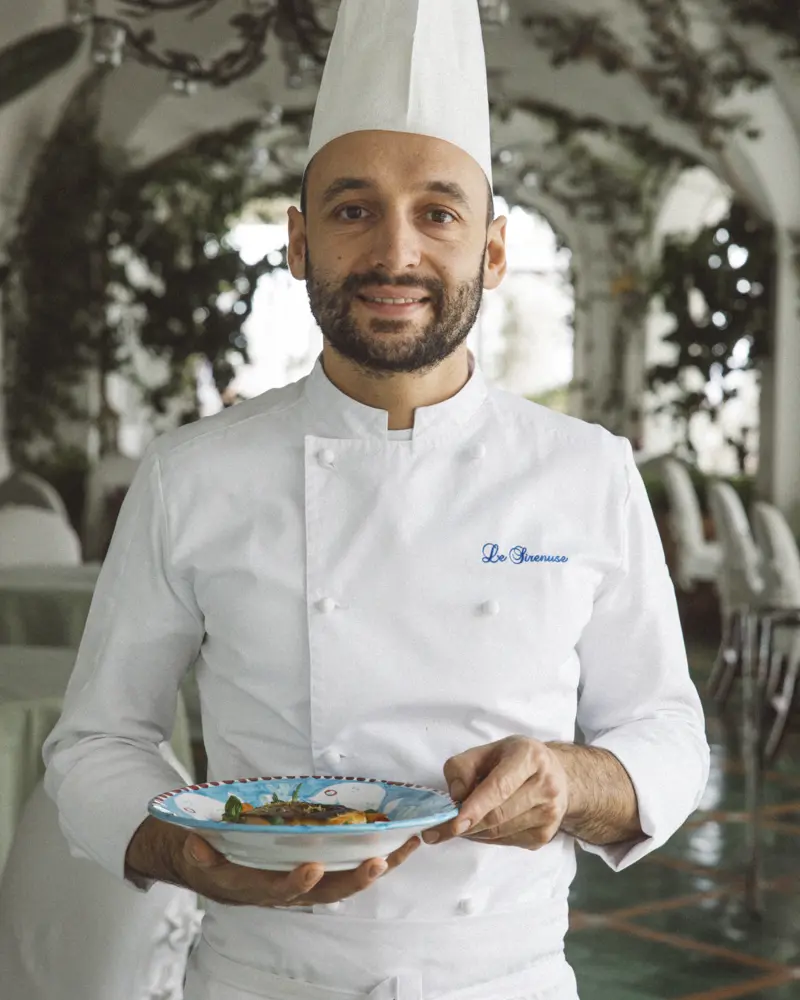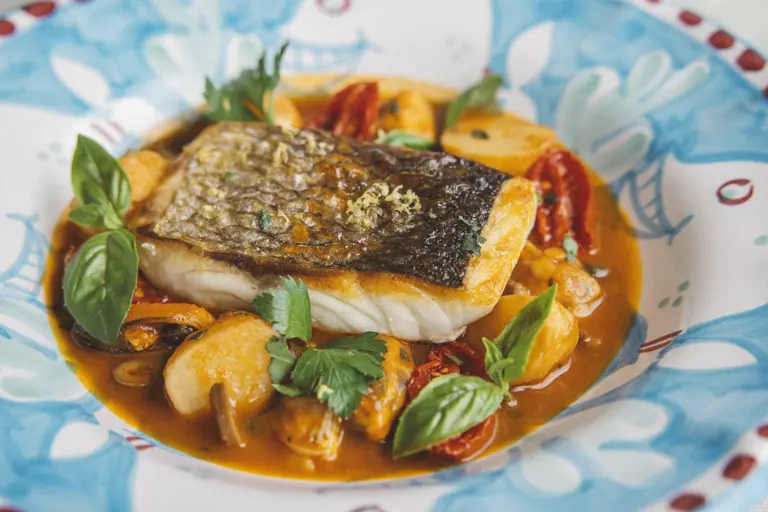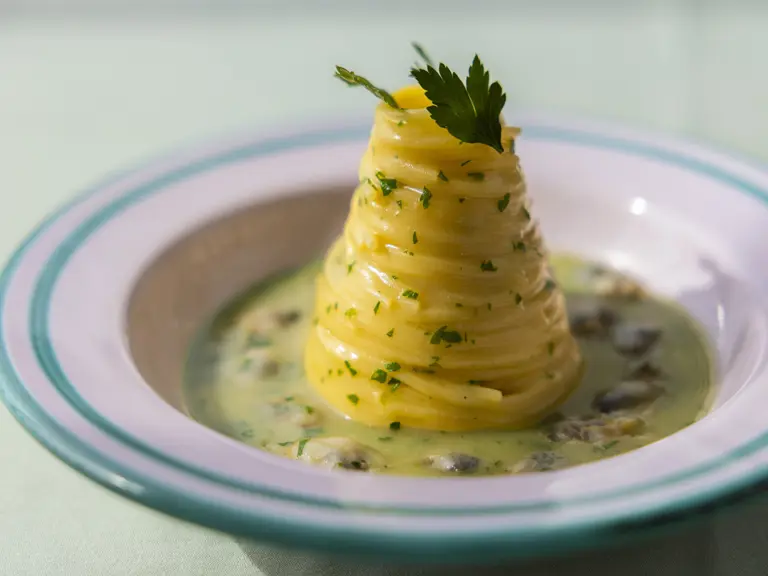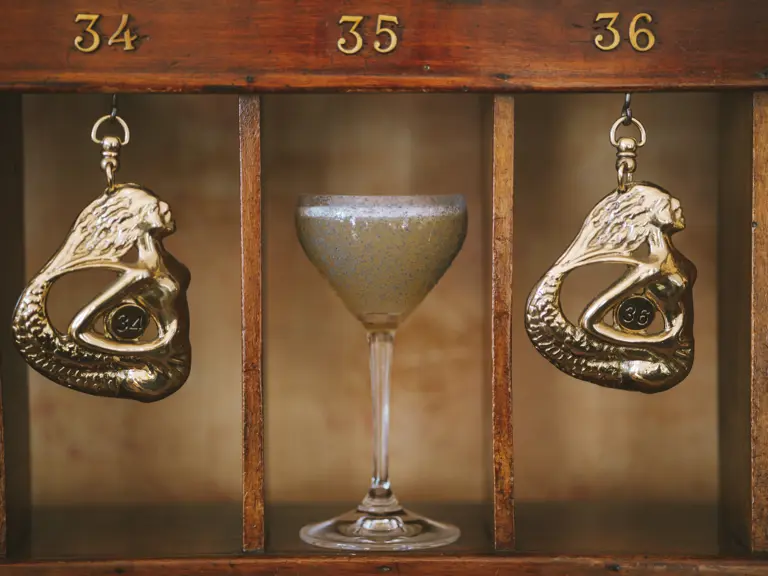THE DISH I COME HOME TO: FRANCESCO ANASTASIO, 'ACQUA PAZZA' SEA BREAM
29.10.2025 RECIPES
Many of the Amalfi Coast’s inland villages look to the land rather than the sea for culinary ingredients, but Pontone is so close to Amalfi that fish and seafood were a staple of the Anastasio family’s diet when he was a boy.
Francesco’s affection for this traditional fish main course, which creates magic out of a few simple ingredients, goes back to his earliest days as a trainee chef. “This was one of the first dishes I ever cooked”, he explains, “when I’d just been given a job in the kitchen of a restaurant called Da Teresa, in Amalfi”. He never really had to study the recipe, he tells the Journal. “It’s an Amalfi Coast classic, one of those that you grow up knowing how to make, it’s part of your DNA”.

Acqua pazza literally means ‘crazy water’. It refers to a method of cooking white fish on the stovetop (though it also possible to achieve a similar effect in the oven) in a thin broth or guazzetto, typically of fish or seafood juices, extended and given colour through the addition of tomato passata or purée. Often, as in this recipe, the fish will have been previously scottato or seared before it’s added to the pan with the broth.
If you’ve had a bit of experience with fresh fish, feel free to fillet the sea bream yourself. Alternatively, ask you fishmonger to do it, leaving the skin on one side. To end up with four fillets of around 750g in total, you’ll need a fish at least twice that size by weight.
Datterino tomatoes are small oblong vine tomatoes with an intense flavour that is a perfect balance of sweetness and acidity. If you can’t track them down in your area, any small, flavoursome variety will do. When Francesco makes this recipe, he brings out the flavour still more by placing the tomatoes in an oven 80°C/175°F for half an hour, but if your tomatoes are good enough, he tells us, fresh is fine too. Taggiasca olives are small, compact, tasty black olives from Liguria. Once again, you can substitute, but try to avoid those big bland ones that taste of very little.
Trancio di branzino all’acqua pazza con guazzetto di frutti di mare
Serves 4
4 branzino fillets of around 180g (6.4oz) each, with skin on one side
15 mussels
15 clams (vongole)
100g (3.5oz) new potatoes
100g (3.5oz) red datterino tomatoes
A tablespoon of fresh tomato sauce or passata, homemade for preference
50g (1.75oz) taggiasca olives
30g (1oz) salted capers, well rinsed
A few basil leaves
A small bunch of flat-leaf parsley, chopped
Olive oil, salt and pepper as needed

Begin by preparing the clams and mussels. Start by rinsing them well under running water. Remove any obvious debris with a rough brush, and check for cracked or broken shells, which should be immediately discarded. (If any shells are slightly open, tap them; if they close, they’re fine, if they stay open, discard them). Then place the shells in a bowl of salted water: calculate a third of a cup of salt per gallon of water, or 80g for 2 litres. You don’t need to do this for hours, taking them in and out of the fridge, as some food writers suggest. Half an hour in your kitchen will be fine. Once they’re purged, rinse and dry them with a tea towel.
In the meantime, peel the new potatoes, cut into manageable chunks, steam them until they’re just knife-tender, then toss them in a pan set on a lively heat with some extra-virgin olive oil – just enough to coat the surface – until they take on colour.
Now pour a generous spiral of olive oil into a heavy-bottomed pan, wide enough to accommodate your four branzino fillets (alternatively, split the whole operation between two pans). Set it on a medium heat, and once it’s nice and hot, add the branzino fillets, skin down, browning on one side for four or five minutes. Remove and set aside, then – adding more oil if necessary – carefully add the mussels and clams. Cover and leave them to open, adjusting the heat as necessary. You don’t want it too high as otherwise all the good juices run by the bivalves will evaporate, but you don’t want it too low either, or they won’t open. Once you’ve given them enough time, discard any shells that have failed to open, then remove the mussels and clams from the good ones and return these to the pan.
Add the fresh tomatoes, the tomato passata, the steamed and lightly fried potatoes, the olives and the capers, along with the chopped parsley and the basil leaves. Stir to amalgamate, adjust the heat to moderate, then lay the branzino fillets on top of the guazzetto or broth you have just created, skin up. Cook for six or seven minutes (this will depend on the thickness of the fillets), then serve on individual plates, surrounded by the tomatoes, potatoes and capers from the guazzetto, with more chopped parsley sprinkled on top.
Photos © Roberto Salomone
Le Sirenuse Newsletter
Stay up to date
Sign up to our newsletter for regular updates on Amalfi Coast stories, events, recipes and glorious sunsets



